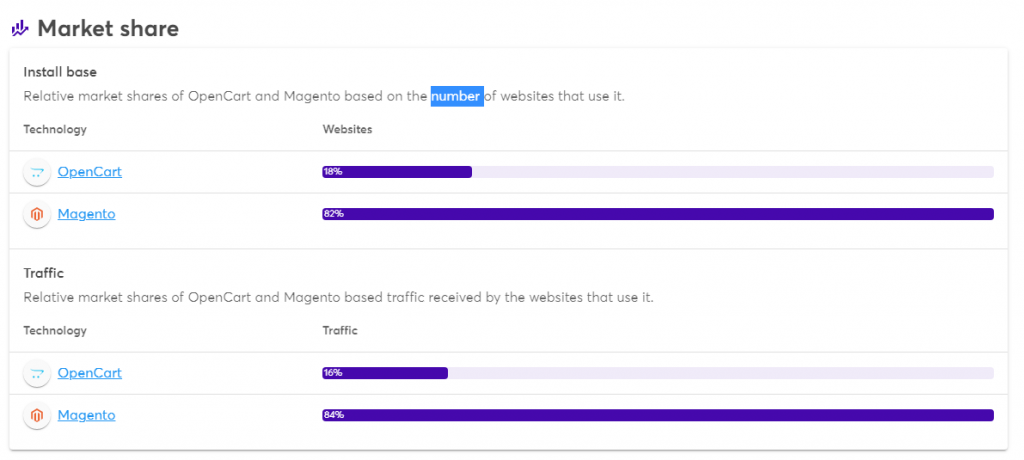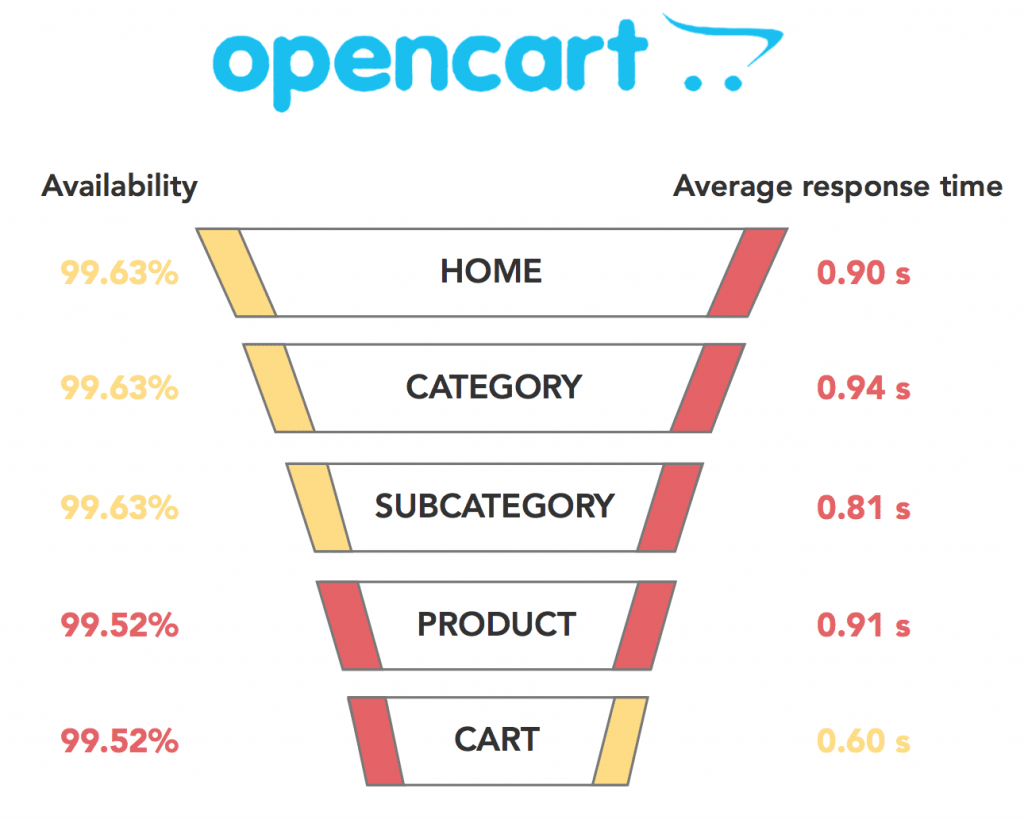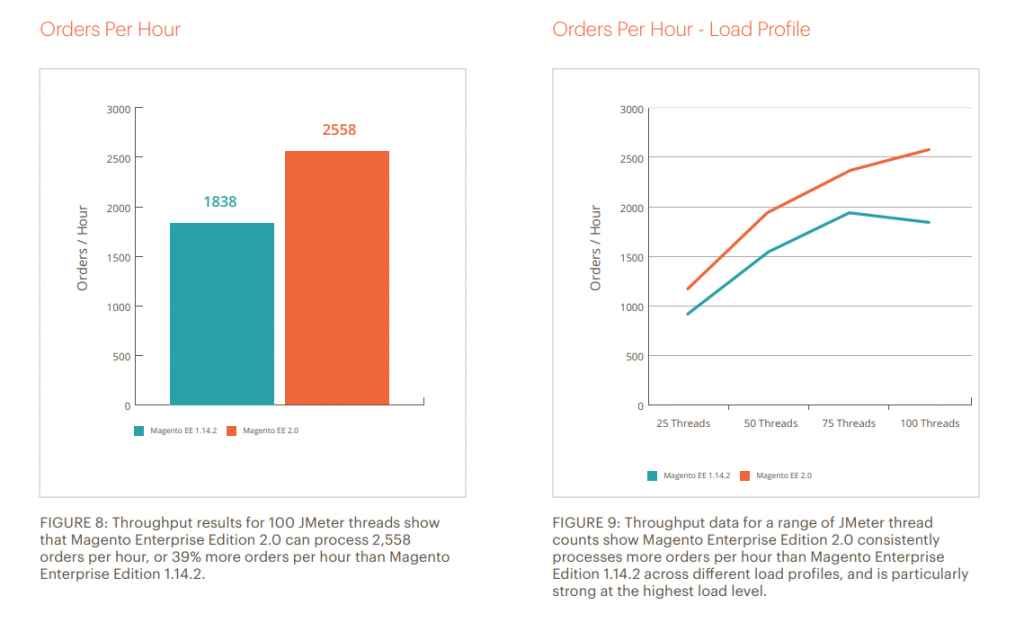When you’re a young entrepreneur, the choice between two similar platforms like Magento vs OpenCart can be tricky.
They are both programmed in PHP and open source. They are both rich in extensions & add-ons. Both platforms hold a reasonable share of the market and a large community of developers.
We’re here to make this decision easier for you. At Elogic, we’ve been dealing with ecommerce website development for over 10 years and can surely tell which ecommerce platform is right for your business.
By the end of this article, you’ll get a clear picture of the pros and cons of Magento 2 vs OpenCart. You’ll find the feature comparison of the two platforms and see the merchant profile each platform suits best. Let’s waste no time and get into specifics!
Magento vs OpenCart: Overview
OpenCart is an open-source online store builder suitable for those looking for higher customization options and lower development costs. It’s completely free to download and boasts of multilingual, multi-currency support. OpenCart powers such websites as British Red Cross gift shop, Missy Empire, and Everbuild.
Magento is also an open-source ecommerce platform offering vast customization possibilities and three editions to meet merchants’ needs. Magento Open Source comes free of charge, while Magento Commerce and Commerce Cloud are paid and play on the high end of the market. Some of the famous brands using Magento are Boodles, Ford, and Nike, among others.


Overall, Magento powers about 81,500 websites globally and is considered a popular ecommerce solution. It may have a steeper learning curve but holds a larger market share than OpenCart.
This Magento vs OpenCart review is yet another addition to our platform comparison articles on the blog. See more on the differences between Magento and such ecommerce solutions as Shopify, BigCommerce, Drupal Commerce, and WooCommerce.
Magento vs OpenCart: Full Comparison
Obviously, you can’t make an informed decision based on a single chart. Let’s take a closer look into what Magento and OpenCart have to offer in terms of ease-of-use, theme selection, features and extensions, hosting, security, SEO friendliness, support, and pricing.
Ease of Use
OpenCart rightfully touts itself as an easy-to-set and user-friendly platform. Its simple 4-step installation guide ends with an automatic installer, so you won’t have to worry about programming your way through the setup. As an open-source system, OpenCart may still require some programming knowledge to edit themes or create a custom module. However, if pre-build extensions are sufficient for your business, you won’t need to code.
As soon as you fire up an OpenCart store, you’ll see an extremely intuitive Admin panel allowing you to manage the store smoothly without any prior training. Download extensions, add products, change the theme — all using the tabs on the left side of the Admin bar.

Magento’s store setup is more meticulous than that of OpenCart. To set up a Magento 2 store, you’ll need to download Magento files via Composer or via the Web Setup Wizard. Solid knowledge of programming is required. So don’t be surprised if you incur extra expenses for hiring an expert Magento tech team to help you out with the installation.
Right after the setup, you should find an intuitive Admin panel to further configure your store catalog, set up multiple storefronts, add SEO metadata, etc. It might look complex at first; yet, it offers a much broader view of your store operations.

Features and Extensions
Features are often a decisive factor when choosing an ecommerce platform. A starter entrepreneur may be satisfied with a basic feature set. Meanwhile, an experienced merchant will look for more features out-of-the-box, which often means less investment in add-ons & extensions later.
OpenCart offers a basic feature set to start a store and build up on its functionalities with the help of extensions. Here are some OpenCart features out of the box:
- Admin dashboard, user management, and multi-store creation
- Different options and attributes for products and categories
- Integrated discounts, coupons, specials
- Unlimited products, categories, and manufacturers
- The possibility to sell digital products
- Multiple languages, currencies, and shipping methods supported
- Sales reports and printable invoices
A more detailed list of features may be found on OpenCart website. In case some feature is lacking, you can browse through a library of 13,000+ OpenCart extensions and add-ons, both free and premium.
Magento’s list of features is much more versatile, especially in the area of marketing and SEO. Let’s take a look at the basic features present in a free edition of Magento Open Source:
- Marketing, Promotions, and Conversion Tool (good for up-selling and cross-selling)
- Site Management
- Search Engine Optimization
- Catalog Management
- Product Browsing (create wish lists, check stock availability, share on social media)
- Catalog Browsing
- Checkout, Payment, and Shipping
- Order Management
- Customer Accounts
- Customer Service
- International Support
- Analytics and Reporting
- Mobile Commerce
The paid editions of Magento — Commerce and Commerce Cloud — further expand the aforementioned list of features. You can follow the link to learn more about each of them.
Besides, Magento marketplace currently has 3,500+ add-ons, and professional Magento development agencies (like Elogic!) can develop a custom module for you. So have no worries — there are plenty of ways to extend the functionality of your website unless you find a required feature.
Theme Selection
Any merchant would want to cut a dash with an impressive unique design. The merchants of both OpenCart and Magento have three theme selection options:
- Pre-built layouts from the official marketplaces: about 500 themes ranging up to $70 for OpenCart and 17 themes up to $499 for Magento.
- Community theme websites like TemplateMonster or ThemeForest: mainly free for every ecommerce platform).
- Custom design: the price depends on the developers’ hourly rate and the complexity of the chosen design.
Dress your website for success with Elogic.
Design your website nowHosting
OpenCart is a self-hosted platform, meaning that you’ll need to find a hosting provider for your store. It shouldn’t be a problem, though: OpenCart is a relatively light platform and won’t require extra server capacity. You can even try shared hosting if you’re a starter entrepreneur and upgrade your hosting plan as your store grows. Similarly to Magento, OpenCart provides a Cloud edition and can host your website for you on AWS servers.
Magento can also be a self-hosted and a hosted platform. The only difference is that it will consume a lot of server resources While choosing your Magento hosting provider, opt for dedicated servers with an increased PHP memory limit for better web performance. Meanwhile, the owners of Magento Commerce Cloud may forget about the trouble and will have their website hosted on AWS or Microsoft Azure for them.
Performance & Scalability
As the business gains steam, a merchant would want to scale smoothly without affecting website performance.
Scaling with OpenCart means installing more modules and add-ons for each feature you need in your store. It’s fine if you wish to extend the functionality of a small store; however, as more extensions add up, the website becomes heavier and slower. iQuanta study revealed that an average load time of OpenCart websites is 831 milliseconds, which is 1.6 times higher than the Google guideline for SEO. OpenCart still offers a great opportunity for a merchant to sell internationally: it supports 40+ languages and multiple currencies out-of-the-box. However, a merchant might find scaling on this platform quite challenging.

On the other hand, Magento’s layered architecture makes it a perfect fit for those who look forward to scaling. It allows adding up to 250,000 SKUs, integrating third-party apps, and maintaining high-load traffic without sacrificing website performance. Magento shows strong performance for large, high-volume sites, can process 2,500+ orders per hour, and enables instant response times of under 500 milliseconds for catalog and add-to-cart pages. So you can count on Magento’s scalability potential and rest easy knowing your business grows without a sign of slowing down.

Payment Options
Reliable payment gateways often mean a secure, convenient, and popular platform. And both Magento and OpenCart live up to this expectation.
OpenCart offers 36 integrated payment gateways, including the global ones like Authorize.Net or Amazon Payments and the local ones like Cardinity or Alipay Pay. Most of the core gateways accommodate international payments. If the gateway you’re looking for is not on the list, you can always install an extension and configure another payment method.
Magento supports 12 multi-currency payment gateways and allows offline payments Cash On Delivery, Bank Transfer, etc. Some of the best Magento payment gateways can be integrated via APIs or as an extension.
Security
Both OpenCart and Magento are relatively secure platforms. The platform providers release security patches regularly, plus programmers can further customize the code and install security modules to reduce the store’s vulnerability to cyber attacks.
However, you’ve got to take the good with the bad. Because both OpenCart and Magento are open source, they may be subject to XSS issues and code execution problems. Thus, merchants are advised to follow best OpenCart and Magento security practices, like do regular store backups and user encrypted protocols, to prevent the customers’ sensitive data leaks.
SEO Friendliness & Marketing Tools
Once your store is up and running, you’ll need to build productive relationships with your audience. Effective SEO and marketing tools are just what you’ll need.
OpenCart offers a pretty basic set of SEO tools. You can edit metadata, add keywords, configure redirects and canonical tags; but that’s basically it. These tools will help you rank your page on Google but won’t get you high in SERP. Consequently, the only way to address the lacking marketing and SEO tools is by installing a pre-built extension or developing a custom one.
Meanwhile, Magento takes its SEO optimization to a whole new level. You can optimize URL, change prefixes and suffixes of the links, configure robots.txt protocols and XML sitemaps in addition to many other features out-of-the-box. Magento Commerce presents even more advanced tools, like PageBuilder or content staging. So a Magento merchant will surely rank high and launch marketing strategies in a few clicks.
User Support
Experiencing technical issues at 3 am? Newly purchased extension doesn’t work? The server is down? That’s when you need user support.
OpenCart offers a dedicated support team as a separate service. At $99/month, you’ll get expert installations support, bug fixes, modules consultation, and up to 48 hours guaranteed response time. In case of emergency, you can also get a one-time fix at the same price of $99. OpenCart also has a large community of 120,000 developers ready to share their advice and expertise on a forum.
Magento presents a 24/7 dedicated support only in its advanced packages of Magento Commerce and Commerce Cloud. The service is already included in the license fees. Still, its community of 335,000 developers is even larger than that of OpenCart. They are ready to help on such trusted magento-related fora as Magento Stack Exchange and Magento Expert. Magento Help Center also contains many free materials, guides, and answers to FAQ, so you’ll never be alone with your web problems.
Cost/Pricing
While calculating the costs of both OpenCart and Magento, you should account for a developer’s hourly rate. Magento For OpenCart, it will be about $40-$80/hr depending on their location, and for Magento — $50-$250/hr. The fewer features a platform offers out of the box, the more you’ll need to spend on technical assistance and development services.
Technically, the cost of OpenCart is free. The installation file is in open access, and no license fees apply. However, sooner or later, you’ll need to expand the core product with new features and modules, the price of which can go as high as $300.
Magento offers three editions all at different prices. The pricing situation with Magento OpenSource is similar to that of Opencart: the cost of entry is free, but you’ll need to spend on hosting, extensions, maintenance, etc. Magento Commerce edition costs $22,000+ annually and includes advanced functionality that you won’t need to extend with add-ons. Magento Cloud Edition sells for a striking $40,000+ per year but is hosted, supported, and upgraded with features for you.
OpenCart vs Magento 2: Comparison Table
Before we announce the winner of the Magento vs OpenCart battle, let’s summarize their characteristics in a handy table.
| Magento 2 | OpenCart | |
| Ease of use | Complex | Relatively easy |
| Source code accessible | Open-source | Open-source |
| Hosting | On-site, third-party, Cloud-based | On-site, third-party, Cloud-based |
| Extensions | 5,500+ | 13,000+ |
| Cost | $50-$250/hr + free access to code (open source) for Magento Open Sourceor $22,000+/year for Magento Commerce Edition (Enterprise)or $40,000+/year for Magento Cloud Edition | $40-80/hr developers rate + free access to code (open source) |
| Features | Feature-rich | Feature-rich |
| Ease of Integration | Flexible | Flexible |
| Theme selection | 12 | 500 |
| Payment Gateways | Support of 12 payment gateways | Support of 36 payment gateways |
| Security | Built-in security patches and regular updates | Regular security updates |
| Scalability | Scalable | Not scalable |
| Multilingual capabilities | Built-in multi-lingual support | Built-in multi-lingual support |
| SEO | Built-in SEO tools, customizable plug-ins and apps | Basic SEO features to be extended with plug-ins |
| Ideal Ecommerce Size | A large enterprise with lots of SKU and resources | SMEs that seek customization |
The Verdict: What’s the Best Platform for You — Opencart or Magento?
OpenCart and Magento may seem similar but still target different merchants.
An ideal OpenCart merchant is a startup or a small company that has a small catalog and a customer base. It is still developing its brand identity, so it doesn’t need many SEO or marketing tools but looks for ways to experiment (which open access to the code absolutely allows).
An ideal Magento merchant is a medium to large enterprise that requires more resources out-of-the-box to run an online store. Magento will be a great option for those who seek good performance and stability during high-volume traffic and wish to scale in the near future.
Let us know if this Magento vs OpenCart review tipped the scales in favor of Magento! We can help you with anything from building a Magento store from scratch to developing a custom module.
Stay on top of your game with the right ecommerce platform.
Use Magento development services
